The market's advance since the presidential election has certainly been remarkable. Much of the gain is being attributed to anticipated policies being proposed by a new Trump administration. Obviously none of the proposed policies have been put in place as of yet, but the market is already weighing in with positive expectations. A common thought is whether or not the market has gotten ahead of itself.
Given the rapid rise in such a short time period, the market certainly seems to be ahead of itself. However, from a return standpoint, it may not be as can be seen in the below chart. Over the last two years the market's return totals just over 8% and all of the return has come since the election. This makes the average return over the last two years only about 4%. 
h/t: Santiago Capital
Much of the positive market sentiment has been driven by a strong improvement in various consumer and business sentiment indicators. Below are a couple of charts showing the spike in a number of sentiment indicators.
Retail Sales and University of Michigan Consumer Sentiment:
In U of M's sentiment report for November the report noted,
Consumer confidence surged in early December to just one-tenth of an Index point below the 2015 peak—which was the highest level since the start of 2004. The surge was largely due to consumers’ initial reactions to Trump’s surprise victory. When asked what news they had heard of recent economic developments, more consumers spontaneously mentioned the expected positive impact of new economic policies than ever before recorded in the long history of the surveys.(emphasis added)
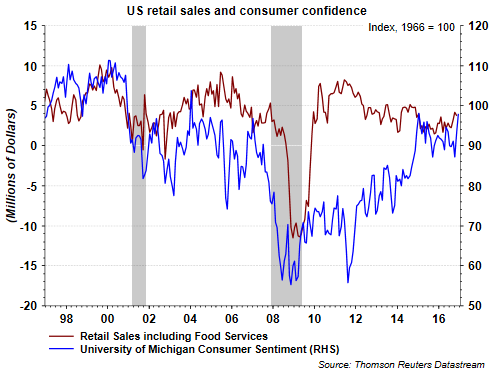
Conference Board Consumer Confidence Index (released 11/29/2016):
The report noted,
Consumer confidence rose sharply following the November 8 election, up 6.3 points to 107.1 for by far the best reading of the cycle, since July 2007. November's current conditions component is up 7.2 points to 130.3 and is led by strong gains in the assessment of business conditions and those saying jobs are plentiful. Those saying jobs are hard to get, which is closely watched as a barometer for monthly jobs data, is unchanged, at a very low 21.7 percent in what is a favorable indication for Friday's report.

IBD/TIPP Economic Optimism Index;
A few highlights from the report.
The IBD/TIPP Economic Optimism Index jumped 3.4 points, or 6.6%, to a 10-year high of 54.8 in December from 41.4 in November. The index reading was the first since real estate magnate Donald Trump won the 2016 presidential election, upsetting heavily favored Democratic candidate Hillary Clinton. The index is now 6.2 points above its 12-month average of 48.6. And it's a hefty 10.4 points above the 44.4 level in December of 2007, the month that the U.S. officially entered recession. Raghavan Mayur, president of IBD's polling partner TechnoMetrica, estimated the "Trump effect" on the poll at "approximately eight points" for the month (emphasis added.)
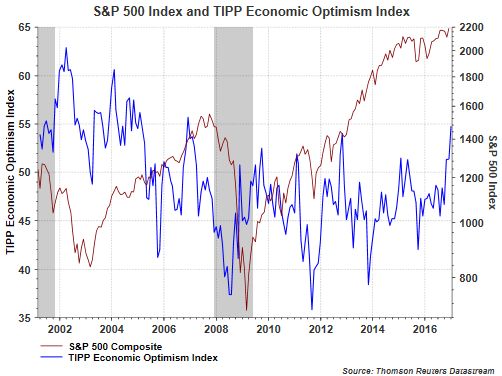
NFIB Small Business Optimism Index (released 12/13/2016):
The NFIB Small Business Optimism report noted,
Small business optimism remained flat leading up to Election Day and then rocketed higher as business owners expected much better conditions under new leadership in Washington, according to a special edition of the monthly NFIB Index of Small Business Optimism, released today.
“What a difference a day makes,” said Juanita Duggan, President and CEO of the National Federation of Independent Business (NFIB). “Before Election Day small business owners’ optimism was flat, and after Election Day it soared.”
The full November index, calculated as it is every month, improved 3.5 points to 98.4, which is just above the 42-year average and only the third time since 2007 that it has broken into above average territory. Plans to hire jumped five points from the previous month. Expected higher sales rose from a net one percent in October to net 11 percent in November. But the blockbuster was expected better business conditions, which shot from a net -7 percent to 12. “Even without separating the data, the November results paint a starkly different picture than what we’ve seen in the last 94 months,” said Dunkelberg.
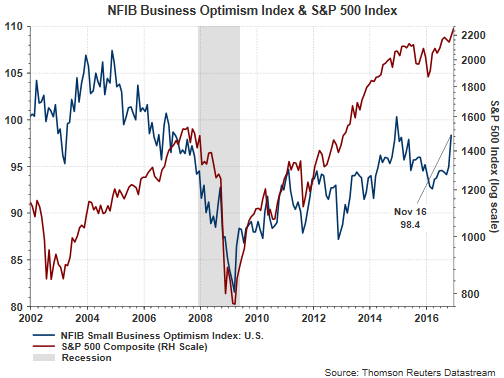
This vast improvement in sentiment has led to improved investor sentiment, but is it over done? As the below chart shows, investor cash levels, as a percentage of all mutual fund assets, are at extremely low levels. If this is the case, where does the additional cash come from to invest in more equities? Some cash is anticipated to flow out of bond or fixed income investments with higher interest rates on the horizon. 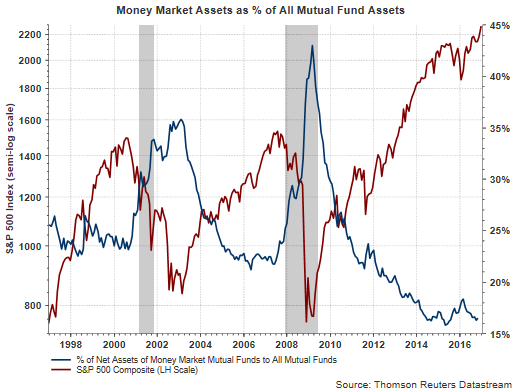
The data also suggests institutional investors are fully invested based on the NAAIM Exposure Index reading of 96%.
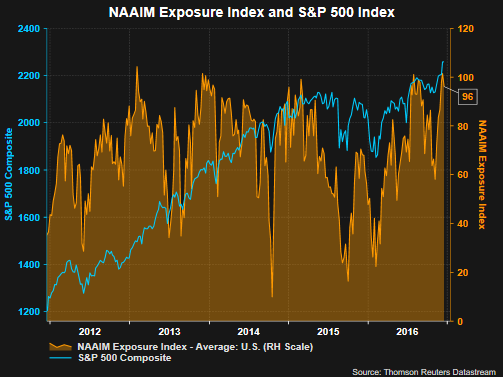
The Rydex Asset Ratio shows how investors are actually allocating investment funds. This ratio consists of all Rydex funds invested long in stocks compared to all index funds that are short the stock market, including money market funds. As the below chart shows, the resulting ratio of bull/bear assets is at an extreme low, indicating many more dollars are invested in the long only funds. 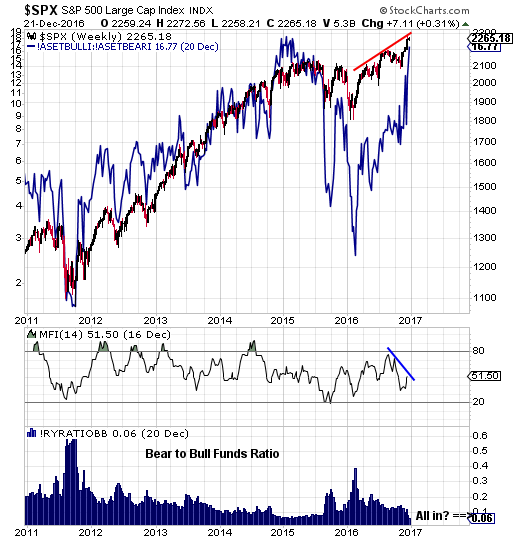
Source: NorthmanTrader
So it would seem equities might be a little ahead of themselves and this may be the case. From a valuation perspective though, and with earnings improving for companies, valuations do not seem at extreme levels. Below is a chart showing the total market value of corporate equities to corporate profits. This profit number is pulled from the profit figure used in the calculation of GDP. Also noted on the chart is the equity value in relation to GDP. GDP has been growing at a below trend rate, and if the economy (GDP) had grown at its historical trend rate, this valuation measure would be lower as noted by the dot on the chart. 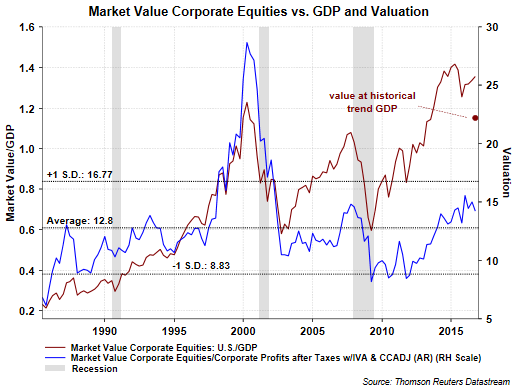
Finally, if the market is ahead of itself and due for a pullback, long term investors should evaluate the longer term prospects of the economy and the likelihood that corporate earnings improve. It is difficult to time in and out of the market and investors that attempted that in 2013 missed the sizable gain generated by the S&P 500 Index. In 2013 the S&P 500 Index was up nearly 30% on a price only basis. 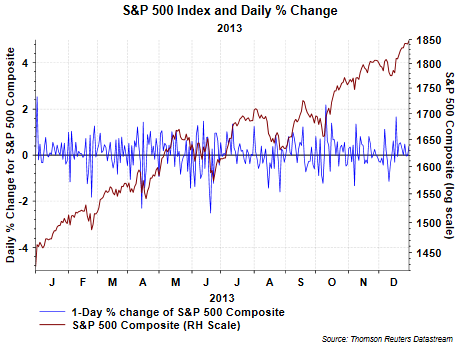
As the above chart shows, the market frequently swung (blue line) from positive returns to negative returns on what appears to be a nearly daily basis. There were several consolidation periods where the market declined between 4% and 6%. For the calendar year there were 260 trading days and the average of the 144 up days was .57% and the average for the 104 down days equaled -.53%. In fact the biggest market moves were to the downside.
Now I am not predicting a 30% return in the market for 2017; however, the market will most certainly go through contractionary periods as the months ahead unfold, and with the broadly elevated sentiment levels, this is pretty much a given. Investors that attempted to time the market in 2013 likely missed out on the 30% return the market generated. Having a disciplined investing plan and strategy is always important especially in light of the recent sharp move higher in stocks.
